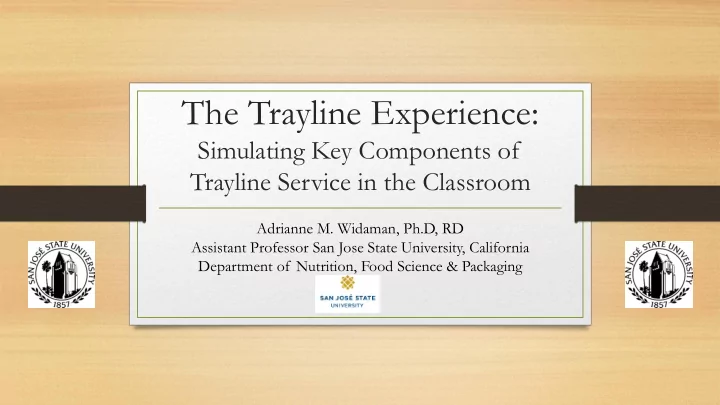

The Trayline Experience: Simulating Key Components of Trayline Service in the Classroom Adrianne M. Widaman, Ph.D, RD Assistant Professor San Jose State University, California Department of Nutrition, Food Science & Packaging
Objectives • Discuss strategies to replicate meal assembly in foodservice management curriculum • Demonstrate how a classroom trayline simulation increased knowledge in foodservice management university students. • Discuss techniques to demonstrate distribution and service in the classroom • Learning codes 6030 education theories and techniques for adults 6050 instructional material development 8050 food distribution, service
Foodservice Systems Model Procurement Production Distribution/Service Safety Sanitation Adapted from Gregoire, 2016
Distribution • Food Product Flow in a Conventional Hospital Foodservice Procurement - Production – Hot Holding – Meal Assembly – Transportation – Service to Customer • Major Challenges of Distribution • Food must be kept at the proper temperature • Quality must be maintained
Centralized Meal Assembly • Centralized meal assembly - centralized trays assembled near main production area, transported for service • Example: trayline - a line for service where patient trays are assembled and check for accuracy before food is delivered to patients
Relevance • Entry- Level Dietetics Practice Audit • Entry level Registered Dietitians and Registered, Nutrition and Dietetic Technicians work in acute or long term care (37% and 39%) • “Meal assembly” and “monitoring food and service standards” is considered a high risk, core activity for the entry level NDTR • Meal assembly (RD 9%; NDTR 34%) • Monitoring food and service standards (RD 29%, NDTR 36%)
Consequence of Errors 1. Patient safety 2. Customer satisfaction 3. Quality assurance
Barriers to Field Experience • Tuberculosis screening, MMR immunization x 2, current flu shot, HIPPA training, background screening, contract with facility.
Simulation • Simulation - imitates the operation of a real-world process • Develop the model representing key characteristics of the process • Technique for learning that can be applied to many different disciplines and trainees. • Active learning technique
Curriculum • Videos and images to “transport” students into the trayline environment. • 30-45 minutes • Content available to share: add name to list email: adrainnne.widaman@sjsu.edu • Describes trayline in context of the distribution aspect of transformation in the foodservice systems model • Process examples • For example – paper menu-based system; select menu, 1 week cycle menu
Curriculum Cont. • Visuals • Video examples of a trayline for a very large facility vs. trayline for a small facility • Tray accuracy checks – return demonstration • Examples of trayline quality assurance checks and temperature logs
Tray Audit 800 Bed Facility Start time: End time: Trayline duration (minutes) Number of trays: 800 Number of workers: 25 Trays per minute: Person minutes per tray:
Curriculum Cont. • Students independently calculate performance measures (i.e. trays per minute, person minutes per tray, tray accuracy audit) • Emphasize the specialized training requirements of the checker • Debriefing • Priorities based on operation’s objectives (food safety, quality, budget) • Strategies based on number of beds • Personnel management strategies
Objective • Evaluate the effectiveness of the trayline simulation
Methodology • Subjects • Senior undergraduate/graduate students in a upper division undergraduate course • Food service management – procurement and management • 4:1 female to male ratio 1. Pretest 2. Trayline simulation 3. Post test • Data Analysis • Scores calculated (%) • Statistical Analysis – repeated measures ANOVA
Results • n=48 • 38 undergrad • 10 graduate students • How effectives was the trayline simulation? • Scores ranged from pre test 4%-75% and post test 58%-100% • Overall: Pretest 45.6%(SD 15.4%); post 80.5%(10.2%) • Statistically significant increase in scores (p<0.0001)
p<0.0001
Results Cont. • Did scores differ between undergraduate and graduate students? • Undergraduate / graduate pretest scores • 46.1% (SD 16.2%) / 43.8%(12.0%) • Undergraduate / graduate post test scores • 80.3%(9.3%) / (81.3 (13.8%) • No difference in scores between undergraduate and graduate students (p=0.598)
Conclusions • During 1 class period, the trayline simulation was effective at significantly increasing central assembly distribution knowledge in students in a foodservice management course. • There was no difference in pre or post test scores of undergraduate and graduate students. Suggesting both groups came in with similar background knowledge and gained equivalent knowledge from the trayline simulation. • The trayline simulation activity was effective.
Limitations • Good internal validity. Limits to external validity – pretest may influence results • Small study size • Long term retention of knowledge not measured.
Next Steps • Measure long-term retention (end of course) • Additional study needed • Compare the impact of simulation vs. field experience on knowledge, retention and competency
References Gregoire MB. Foodservice Organizations: A Managerial and Systems Approach. 9th ed. Boston: Pearson Education Inc.; 2016. Griswold K, Rogers D, Sauer KL, Kellogg Leibovitz P, Finn JR. Entry-Level Dietetics Practice Today: Results from the 2015 Commission on Dietetic Registration Entry-Level Dietetics Practice Audit. J Acad Nutr Diet. 2016;116(10):1632-1684. Lateef F. Simulation-based learning: Just like the real thing. J Emerg Trauma Shock. 2010;3(4):348-352. Fanning RM, Gaba DM. The role of debriefing in simulation-based learning. Simul Healthc. 2007;2(2):115-125. Dowling RA, Cotner CG. Monitor of tray error rates for quality control. J Am Diet Assoc. 1988;88(4):450-453.
Contact Information Adrianne M. Widaman, PhD, RD Assistant Professor Department of Nutrition, Food Science, and Packaging San Jose State University, San Jose, California Email: adrianne.widaman@sjsu.edu
Recommend
More recommend